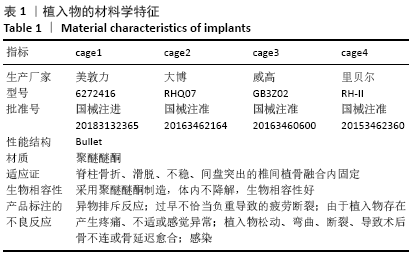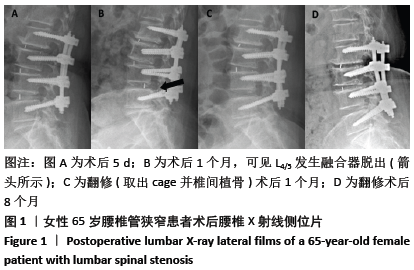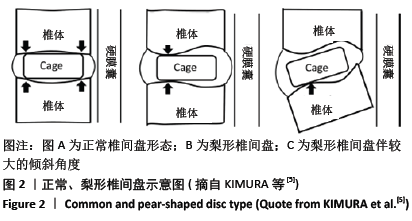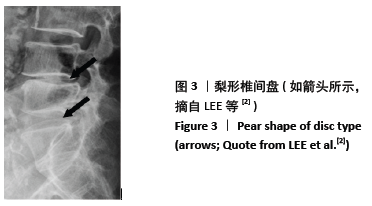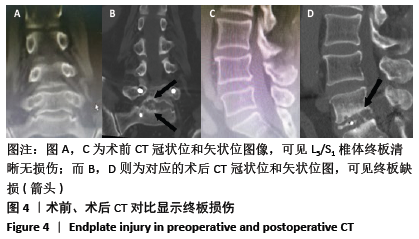中国组织工程研究 ›› 2021, Vol. 25 ›› Issue (18): 2856-2862.doi: 10.3969/j.issn.2095-4344.3836
• 脊柱植入物 spinal implant • 上一篇 下一篇
腰椎融合过程中终板损伤与术后融合器脱出的关系
张明彦1,刘向阳1,常 磊1,陈 晶2,沈雄杰1,刘 斌1,彭 帅1,张 超1,吴环宇1,朱 峰3,牟海频4
- 湖南省人民医院(湖南师范大学第一附属医院),1脊柱外科,2内分泌科,湖南省长沙市 410021;3桃江县人民医院骨科,湖南省桃江县 413400;4张家界市人民医院骨二科,湖南省张家界市 427400
Relationship between the intraoperative endplate injury and cage retropulsion after lumbar interbody fusion
Zhang Mingyan1, Liu Xiangyang1, Chang Lei1, Chen Jing2, Shen Xiongjie1, Liu Bin1, Peng Shuai1, Zhang Chao1, Wu Huanyu1, Zhu Feng3, Mou Haipin4
- 1Department of Spinal Surgery, 2Department of Endocrinology, Hunan Provincial People’s Hospital (the First Affiliated Hospital of Hunan Normal University), Changsha 410021, Hunan Province, China; 3Department of Orthopedics, Taojiang County People’s Hospital, Taojiang 413400, Hunan Province, China; 4Second Department of Orthopedics, Zhangjiajie City People’s Hospital, Zhangjiajie 427400, Hunan Province, China
摘要:
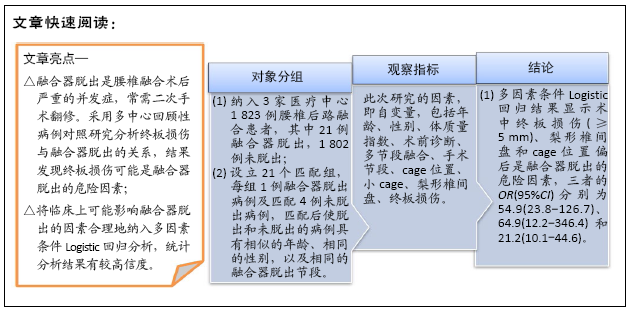
文题释义:
融合器脱出:cage的后缘向后超出相邻椎体的后缘。
终板损伤:腰椎融合术前患者CT显示手术融合节段的终板完整,即终板的高密度线条结构清晰完整无中断及缺损;而术后CT则显示终板高密度线条后缘部分缺损,即终板后缘损伤。
背景:腰椎后路融合治疗腰椎退行性疾病取得了满意的疗效,但并发症融合器脱出偶有发生。关于融合器脱出的原因,学术界一直未有统一认识,可能与年龄、性别、体质量指数、术前诊断、多节段融合、手术节段、cage位置、小cage、梨形椎间盘、骨质疏松、单边螺钉固定等有关。而作者于临床实践中发现大部分融合器脱出的患者术后CT可见融合节段的终板后缘损伤,因此文章探讨终板损伤与融合器脱出的关系。
目的:探讨腰椎后路融合术后融合器脱出的原因,分析术中终板损伤与融合器脱出的关系。
方法:对2014年1月至2018年12月3家临床医疗中心1 823例行腰椎后路融合治疗的病例进行回顾性研究,其中融合器脱出组21例,融合器未脱出组1 802例,采用t 检验比较两组患者年龄、多节段融合的差异,使用χ2检验比较两组性别、术前诊断、手术节段的差异。建立21个匹配组,每个匹配组随机分配1例融合器脱出病例,再从融合器未脱出病例中分配4例与同一匹配组内的融合器脱出病例具有相同性别、相似年龄(年龄差<±2岁),且手术融合节段包括融合器脱出病例发生cage脱出的节段。使用多因素条件Logistic回归对21个匹配组进行融合器脱出的危险因素分析,纳入回归分析的自变量有术中终板损伤(≥5 mm)、梨形椎间盘、cage位置、小cage以及体质量指数。
结果与结论:①融合器脱出组的平均年龄是63.3岁,融合器未脱出组的平均年龄是58.7岁,经t 检验,差异有显著性意义(P < 0.05);而融合器脱出和融合器未脱出组的平均融合节段数分别是1.9和1.8,经t 检验,差异无显著性意义(P=0.664);两组间性别、术前诊断和手术节段采用χ2检验,差异均无显著性意义(P > 0.05);②多因素条件Logistic回归结果显示,术中终板损伤(≥5 mm)、梨形椎间盘和cage位置偏后是融合器脱出的危险因素,P均< 0.05,三者的OR(95%CI)分别是54.9(23.8-126.7)、64.9(12.2-346.4)和21.2(10.1-44.6);③提示腰椎后路融合术中终板损伤≥5 mm与术后融合器脱出有相关性,是融合器脱出的危险因素;建议术中不要反复使用较大型号铰刀(12#)清理椎间盘,尤其是髓核严重退变、椎间隙狭窄、病变椎间盘呈梨形的患者。
中图分类号:
